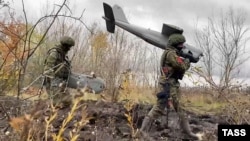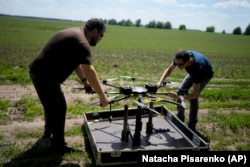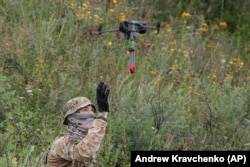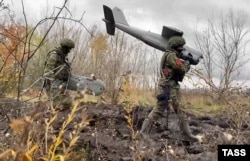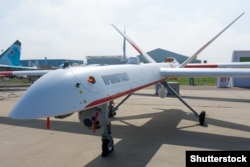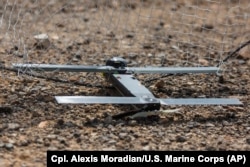Pilotless aircraft have become arguably the most significant technological development of modern conflict. Here are some of the drones known to be in use above the battlefields of Ukraine.
Aerorozvidka R18
The Ukrainian-made R18 octocopter is specifically designed for bomblet drops. The drone has been stripped of everything but the bare essential components in order to maximize its payload capacity of around 5 kilograms. Even landing legs have been deleted, meaning it requires a special platform to take off and a human “catcher” to land.
The R18 can fly without lights in the dark for total visual stealth, while using thermal-imaging cameras to spot enemy troops and vehicles. Videos captured by the octocopter show Russian tanks being wiped out by cheap, armor-piercing grenades fitted with 3D-printed tail fins.
Eight-propeller octocopters such as the R18 offer more reliability than the more common quadcopters. Even if one motor fails or gets shot away, an octocopter can continue flying.
Twenty crews operating the R18 drones are reportedly on the front lines of the war in Ukraine.
Kvazimachta
This nonlethal drone, which Russia dubs a "hardware-raising system," is designed to hover in place and cannot roam beyond the length of the electrical cable attached to a command station on the ground that feeds the drone power. That tether limits the altitude of the coffee-table-sized quadcopter to around 70 meters, but allows it to stay aloft for a claimed period of three days before it must land for maintenance checks.
The Kvazimachta carries a camera and telecommunications hardware that allow it to serve as a kind of hovering “mast” that can be rapidly relocated and is less vulnerable to artillery attacks than a fixed telecoms tower.
DJI Mavic series
Chinese drone manufacturer DJI designs its drones mostly for filmmakers and photographers, but both sides in the Ukraine conflict use DJI copters for reconnaissance, artillery correction, and for dropping small antipersonnel grenades.
The latest Mavic (pictured) is fitted with a low-quality telephoto lens, which allows for surveillance of targets from beyond earshot, and a more crisp wide-angle lens. The quadcopter is powerful enough to carry and drop single grenades fitted with impact fuses.
But the out-of-the-box versions of the drones come with a high risk for operators in conflict situations. DJI, the maker of the drones, also sells a radar system specifically designed to detect DJI copters. Users of the Aeroscope anti-drone radar can pinpoint the exact location and flight path of a DJI copter and the person flying it, meaning artillery can quickly and precisely target drone pilots even if they are hidden from view.
A Ukrainian volunteer told RFE/RL in July that the Aeroscope detection system is believed to be in use by Russian forces. The volunteer said that “unfortunately, examples exist” of Ukrainians being killed by artillery aimed with the help of the radar.
DJI has stopped sales of its drones in Ukraine and Russia, but easy importing from neighboring countries makes the move largely symbolic.
Orlan-10
The airplane-shaped Russian drones are catapulted into flight, then kept aloft for up to 16 hours by a noisy, fuel-powered engine. The fixed-wing drones use cameras and sensors mostly to correct artillery barrages and prowl for enemy movement, but the aircraft have been documented dropping multiple bomblets from pods beneath their wings.
Orlans are also reportedly capable of jamming local cell-phone towers and “SMS bombing” of enemy troops. Since 2014, frontline Ukrainian soldiers fighting Russia-backed separatists began receiving grim text messages warning them to lay down their arms.
Bayraktar TB2
The Turkish-made drones were initially seen as a game-changer for Ukraine when videos showed the Bayraktars destroying valuable Russian hardware with baseball-bat-sized "micromunitions" during the chaotic first days of the Russian invasion.
A song about the Bayraktars became a popular tune for buskers on the streets of Ukraine, and European civilians fund-raised to supply more of the aircraft to Ukraine. But as the Russian invasion slowed and layers of air defenses were established in occupied areas, the drones became increasingly vulnerable. The noisy, Cessna-sized aircraft are easily spotted with radar and slow enough to be sitting ducks for antiaircraft weapons.
As early as June, Ukrainian fighter pilots were describing the Bayraktars as “almost useless,” and they are reported to now be largely used for special long-distance reconnaissance missions.
Kronshtadt Orion
The Russian Orion has a similar silhouette to the American-made Reaper combat drone. A distinctive V-shaped tail reduces the aircraft’s radar signature by avoiding radar-catching right angles, and its slender 16-meter wingspan is narrow enough to boost fuel efficiency for a flight time of up to 24 hours. The aircraft has been filmed firing guided air-to-air missiles.
Orions recorded several strikes on Ukrainian vehicles in the weeks after the February invasion, but one was shot down by Ukrainian forces in April, which observers say would have dealt a significant blow to Russian tactics.
Switchblade 300
These American-made “suicide drones” weigh just 2.5 kilograms, and the entire system can be carried in a backpack. Switchblades are deployed from a mortar-like tube that pops them into the air before their wings flick into place and their propeller buzzes to life.
Switchblades use a live video feed to zero in on targets up to 10 kilometers away at a speed of up to 160 kilometers per hour. The flying bomblets are fitted with a grenade-sized warhead capable of killing enemy fighters and damaging unarmored vehicles.
In October, Iran revealed what appears to be a direct copy of the Switchblade.
Geran-2
The Iranian-made, Russian-branded suicide drones are launched in small “swarms” of five or more that can be enough to overwhelm some air defenses. The flying bombs shocked the world when several slammed into Kyiv in mid-October in full view of international journalists, killing at least five people, including a pregnant woman and her husband.
Soon after the harrowing October attacks, Ukraine received advanced Western air-defense missile systems. A crowdfunding campaign was also launched in the Czech Republic to purchase mobile antiaircraft guns specifically for Ukrainian use against suicide drones.




